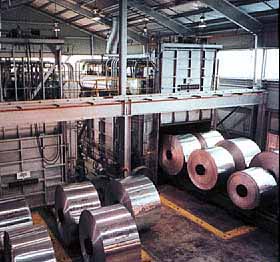Heat Treating: Process Description

Courtesy of SECO/WARWICK
Equipment
Combustion Technology
Energy Consumption
Process Description
R&D Trends
NOTICE: The following PowerPoint presentations are NOT available in this public version of the Metals Advisor.
Three PowerPoint presentations are available to assist you in learning about heat treating. Each presentation will open in a new window. Please note, viewing Powerpoint files online works best in Microsoft Internet Explorer v5.0 or greater. Users of other browsers may wish to download the Powerpoint files for offline viewing instead.
View Online
Heat Treating Industry and Process Overview
(covers commonly used processes, applications in the aluminum and steel industry, information about gas fired furnaces, radiant tubes, electrical heat treating systems, vacuum furnaces, induction heating, and process atmospheres for heating)
Heat Treating Industry, Process, and Equipment Pt.1
(covers an overview of heat treating, commonly heat treated metals, gas fired furnaces, radiant tubes, electrical heating for heat treating, vacuum furnaces, induction, cost distributions for various technologies, and tools and models.)
Heat Treating Industry, Process, and Equipment Pt. 2
(covers heat treating at a glance, heat treating processes, gas fired furnaces, process atmospheres, electrical heating systems, and vaccuum furnaces, as well as supplementary information on the specific effects of heat treating.)
Download
Heat Treating Industry and Process Overview (24.5 MB)
Heat Treating Industry, Process, and Equipment Pt.1 (24 MB)
Heat Treating Industry, Process, and Equipment Pt. 2 (14.3 MB)
As a result of manipulating the shape of aluminum, or through the cooling of molten aluminum, undesirable mechanical properties and stresses are induced in the material. Heat treating encompasses a variety of processes by which carefully controlled changes in the temperature of the metal are used to improve the materials mechanical properties and stress conditions. Solution heat treatment, quenching, precipitation heat treatment, and annealing are all different methods used to heat treat aluminum products.
Undesirable mechanical properties and stresses are induced in the formed aluminum as a result of the changes in shape and cooling from the manufacturing processes. Heat treating encompasses a variety of processes by which carefully controlled changes in the temperature of the metal are used to improve the materials mechanical properties and stress conditions.
Glossary:
Solution Heat Treating – Cast, extruded, or forged pieces are heated to 850°F to 1050°F so that soluble alloying elements can diffuse evenly throughout the metal in solid solution. Precise temperature control and timing are important. Larger castings may require up to twenty hours of soaking while thin sheet may require only a minute.
Quenching – After solution treatment, it is important to cool the work-piece quickly to preserve the proper crystalline microstructure. This cooling is usually achieved by water immersion or water sprays. Quenching operations must be carefully integrated with heat treatment furnaces to avoid uncontrolled slow cooling.
Precipitation Heat Treatment – Also called artificial aging, this treatment promotes the precipitation of solute atoms of alloying elements for enhanced strength characteristics. Aging ovens operate in the range of 250° to 350°F. While the process is often integrated with solution heat treatment, a separate furnace is typically used because the heating temperatures and capacity required are much lower.
Annealing – Large work-pieces and those that have been subjected to cold working operations may require annealing, or stress relieving, to soften the metal and relieve the stresses of working. Annealing temperatures range between 300° and 600° with soak times of up to five hours.
J. Miseresky, “Natural Gas Applications in the nonferrous Metals Industry Sector”, Consumers Gas Company, August 1995.
